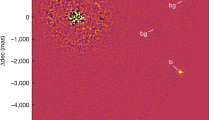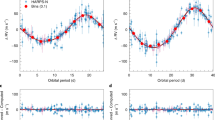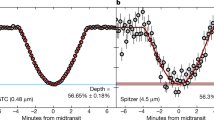Abstract
The discovery1,2,3,4,5,6 of giant planets orbiting nearby solar-type stars raises anew the question of how they formed. Two very different mechanisms have been proposed. Gravitational instability7,8 is the process by which planets form directly from the gas in the accrection disk around the young star. The other alternative is core accretion9,10, where rocky cores of about 10 Earth masses form, followed by the hydrodynamical accretion of gas. Here I show that these processes have very different astrometric signatures, and that it is observationally possible to distinguish between them. Planets that form through gravitational instabilities do so rapidly, so that within just a few hundred years of the onset of the instability the nascent planet is making the young stellar object wobble in its orbit. This can be seen in the youngest stellar objects, with ages as little as 0.1 Myr. If planets form by core accretion, an observable wobble will not be visible for 10–20 Myr. Observations of a suitable ensemble of optically visible young stellar objects (such as those in the Taurus molecular cloud) over a period of several decades should be able to determine which of the two processes is responsible for giant-planet formation.
This is a preview of subscription content, access via your institution
Access options
Subscribe to this journal
Receive 51 print issues and online access
$199.00 per year
only $3.90 per issue
Buy this article
- Purchase on Springer Link
- Instant access to full article PDF
Prices may be subject to local taxes which are calculated during checkout


Similar content being viewed by others
References
Gatewood, G. Lalande 21185. Bull. Am. Astron. Soc. 28, 885 (1996).
Mayor, M. & Queloz, D. AJupiter-mass companion to a solar-type star. Nature 378, 355–359 (1995).
Butler, R. P. & Marcy, G. W. Aplanet orbiting 47 Ursae Majoris. Astrophys. J. 464, L153–L156 (1996).
Butler, R. P., Marcy, G. W., Williams, E., Hauser, H. & Shirts, P. Three new “51 Pegasi-Type” planets. Astrophys. J. 474, L115–L118 (1997).
Cochran, W. D., Hatzes, A. P., Butler, R. P. & Marcy, G. W. The discovery of a planetary companion to 16 Cygni B. Astrophys. J. 483, 457–463 (1997).
Noyes, R. W.et al. Aplanet orbiting the star Rho Coronae Borealis. Astrophys. J. 483, L111–L114 (1997).
Kuiper, G. P. On the origin of the solar system. Proc. Natl Acad. Sci. USA 37, 1–14 (1951).
Boss, A. P. Giant planet formation by gravitational instability. Science 276, 1836–1839 (1997).
Pollack, J. B. Origin and history of the outer planets: theoretical models and observational constraints. Annu. Rev. Astron. Astrophys. 22, 389–424 (1984).
Lissauer, J. J. Timescales for planetary accretion and the structure of the protoplanetary disk. Icarus 69, 249–265 (1987).
Wetherill, G. W. Formation of the Earth. Annu. Rev. Earth Planet. Sci. 18, 205–256 (1990).
Pollack, J. B.et al. Formation of the giant planets by concurrent accretion of solids and gas. Icarus 124, 62–85 (1996).
Adams, F. C., Ruden, S. P. & Shu, F. H. Eccentric gravitational instabilities in nearly Keplerian disks. Astrophys. J. 347, 959–975 (1989).
Laughlin, G. & Bodenheimer, P. Nonaxisymmetric evolution in protostellar disks. Astrophys. J. 436, 335–354 (1994).
Trilling, D.et al. Orbital evolution and migration of giant planets: modeling extrasolar planets. Astrophys. J.(in the press).
Gatewood, G. On the astrometric detection of neighboring planetary systems. Icarus 27, 1–12 (1976).
Beckwith, S. V. W., Sargent, A. I., Chini, R. S. & Güsten, R. Asurvey for circumstellar disks around young stellar objects. Astron. J. 99, 924–945 (1990).
Boss, A. P. & Myhill, E. A. Protostellar hydrodynamics: constructing and testing a spatially and temporally second-order accurate method. I. Spherical coordinates. Astrophys. J. Suppl. Ser. 83, 311–327 (1992).
Boss, A. P. Evolution of the solar nebula. III. Protoplanetary disks undergoing mass accretion. Astrophys. J. 469, 906–920 (1996).
Toomre, A. On the gravitational stability of a disk of stars. Astrophys. J. 139, 1217–1238 (1964).
Snyder Hale, A., Gatewood, G. D., Hale, D. D. S., Persinger, W. T. & McMillan, R. S. The multichannel astrometric photometer with spectrograph: A new instrument for the characterization of extrasolar planetary systems. Lunar Planet. Sci. Conf. XXVIII, 1359–1360 (1997).
Swanson, P. Keck Interferometer Implementation Plan (Jet Propulsion Lab., Pasadena, 1997).
Allen, R. J., Peterson, D. & Shao, M. Proc. SPIE 2871, 504–515 (1997).
Acknowledgements
I thank D. Spergel for prompting this investigation through a cogent question, and J.Graham for improvements to the manuscript. The calculations were performed on the DEC Alpha workstations of the Carnegie Institution of Washington. This research was partially supported by NASA's Planetary Geology and Geophysics Program.
Author information
Authors and Affiliations
Corresponding author
Rights and permissions
About this article
Cite this article
Boss, A. Astrometric signatures of giant-planet formation. Nature 393, 141–143 (1998). https://doi.org/10.1038/30177
Received:
Accepted:
Issue Date:
DOI: https://doi.org/10.1038/30177
Comments
By submitting a comment you agree to abide by our Terms and Community Guidelines. If you find something abusive or that does not comply with our terms or guidelines please flag it as inappropriate.



